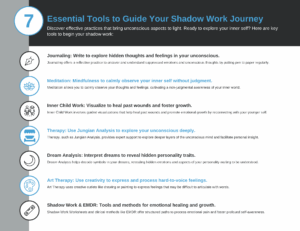Have you ever reacted strongly to something and later wondered, “Where did that even come from?” Or maybe you’ve noticed a pattern in your relationships or emotions that seems to repeat itself, no matter how much inner work you do.
This is where shadow work comes in.
Shadow work is the process of exploring the unconscious parts of yourself—the thoughts, emotions, and behaviors you’ve suppressed, denied, or pushed away. While it can sound a bit intimidating at first, shadow work is one of the most powerful tools for emotional healing, personal growth, and spiritual transformation.
In this beginner’s guide, we’ll explore what shadow work is, why it’s so important, and how you can begin working with your shadow self in a way that feels supportive, grounded, and empowering.
What Is Shadow Work?
The term shadow work comes from the work of psychologist Carl Jung, who described the “shadow” as the hidden or unconscious parts of ourselves—traits, emotions, and desires that we’ve repressed because we learned they were unacceptable, shameful, or unsafe.
But the shadow isn’t inherently bad. It’s made up of parts of you that developed in response to pain, trauma, or conditioning. For example, maybe you learned to suppress your anger to be “good” or to avoid conflict, so now you lash out or shut down when upset. That suppressed anger? It’s part of your shadow.
Shadow work is the process of making the unconscious conscious. It’s about gently shining a light on these hidden aspects so you can heal, integrate, and live more fully as your authentic self.
As Jung famously said:
“Until you make the unconscious conscious, it will direct your life and you will call it fate.”
By getting to know your shadow, you reclaim your power—and start living from a place of wholeness rather than reaction.
Why Is Shadow Work Helpful?
Shadow work isn’t just a psychological exercise—it’s a deeply transformative process that touches every part of your life. When you begin working with your shadow, you stop running from yourself. You meet your inner wounds with compassion. And from that place, true healing begins.
Here are just a few of the powerful benefits of shadow work:
1. Break Cycles of Self-Sabotage
Unacknowledged parts of ourselves often show up as repeated emotional patterns: fear of intimacy, procrastination, jealousy, or a need to control. These patterns may seem irrational on the surface, but they often stem from deeper, buried emotions like shame or abandonment. Shadow work helps you uncover the root causes, so you can stop reacting and start responding with awareness.
2. Improve Relationships
Many of our triggers come from our shadow. When you’re unaware of your own emotional wounds, you might project them onto others. Doing shadow work helps you take ownership of your emotions, reduce conflict, and connect with others from a place of authenticity rather than fear or defensiveness.
3. Enhance Emotional Intelligence
As you explore your shadow, you’ll become more emotionally attuned—not only to yourself but also to others. This self-awareness fosters greater empathy, resilience, and compassion.
4. Deepen Your Spiritual Practice
Spiritually, shadow work invites you into greater wholeness. Instead of striving for love and light while rejecting the parts of you that feel dark or messy, you learn to integrate all aspects of your being. That’s when your vibration truly rises—not by bypassing your pain, but by healing it.
5. Reclaim Your Power
Every time you deny a part of yourself, you give away a little bit of your personal power. Shadow work helps you reclaim those lost fragments. When you’re no longer afraid of who you really are—including the messy, vulnerable, or “unlovable” parts—you become more grounded, confident, and free.
When Should You Do Shadow Work?
Shadow work is incredibly rewarding—but timing matters. Because it often brings intense emotions and long-buried memories to the surface, it’s important to approach this practice with care and readiness.
Signs You Might Be Ready for Shadow Work:
- You keep repeating the same emotional or relational patterns, even when you want to change.
- You feel triggered or emotionally reactive, but you’re not sure why.
- You’re drawn to inner work or feel a strong pull toward healing.
- You’ve begun your spiritual awakening and want to deepen your self-awareness.
- You experience recurring dreams, vivid emotional flashbacks, or synchronicities that point to unresolved issues.
These are clues that your subconscious may be trying to get your attention. Shadow work gives you a way to safely listen.
When to Be Gentle—or Seek Support
Shadow work is powerful, but it’s not always the best first step—especially if you’re currently in crisis, actively processing trauma, or lacking emotional support. If you’re feeling overwhelmed, working with a licensed therapist or trauma-informed guide can help you build the safety and regulation skills you need before diving deeper.
Remember: You don’t have to “fix” everything at once. There’s no rush. Shadow work is a lifelong practice—and every small act of self-awareness is a victory.
How to Start Shadow Work: Step-by-Step
If you’re new to shadow work, it’s normal to feel uncertain about where to begin. The truth is, shadow work doesn’t have to be dramatic or overwhelming. With intention, patience, and compassion, you can start building a relationship with your shadow self in a way that feels safe and empowering.
Here’s a simple, beginner-friendly roadmap to help you get started:
1. Set the Intention
Every meaningful practice starts with intention. Ask yourself:
Why do I want to do shadow work?
Maybe you want to heal emotional wounds, stop repeating harmful patterns, or feel more aligned with your true self. Get clear on your “why”—this will help ground you when things feel intense.
You might say something like:
“I intend to meet my hidden parts with curiosity and compassion.”
Or: “I’m ready to heal what I’ve been afraid to face.”
2. Create a Safe, Supportive Environment
Shadow work isn’t just about what you explore—it’s about how you hold space for yourself in the process. Set up a space that helps you feel grounded and protected. Some suggestions:
- Light a candle or burn cleansing herbs like sage or palo santo.
- Use crystals such as black tourmaline, obsidian, or amethyst for grounding and emotional support.
- Have a journal, a cozy blanket, and a calming drink nearby.
- Begin with a grounding ritual, breathwork, or meditation.
You might also say a brief protection prayer or call on your guides, ancestors, or higher self to hold you through the work.
3. Identify a Trigger or Pattern
The shadow often reveals itself through discomfort. Start by noticing what triggers strong emotional reactions—especially when it seems out of proportion to the situation.
Ask yourself:
- What kind of people or situations trigger me—and why?
- Is there an emotion I try to avoid or suppress?
- What do I judge most harshly in others?
Often, what irritates us in others is something unhealed or denied within ourselves.
4. Dialogue with Your Shadow
Once you’ve identified a trigger or emotion, it’s time to get curious.
Here are a few simple methods to connect with your shadow:
- Journaling: Try free-writing from the voice of the part of you that feels angry, fearful, jealous, or insecure. Let it speak. Ask it what it wants or needs.
- Inner Child Work: Visualize a younger version of yourself at a time when this emotion first appeared. What was happening? How can you offer that version of you compassion?
- Mirror Work: Look into a mirror and speak to yourself gently. Notice any discomfort or emotions that arise—these are invitations to go deeper.
- Meditation: Sit quietly and ask, “What part of me is asking to be seen?” Let any sensations, images, or feelings arise without judgment.
5. Practice Compassion and Integration
This is the most important part. Shadow work isn’t about “fixing” yourself. It’s about integrating the parts you’ve cast aside.
After you’ve explored a shadow, imagine holding that part of yourself with love and acceptance. Say something like:
- “I see you, and I accept you.”
- “It’s okay to feel this way. You are safe now.”
- “All parts of me are welcome here.”
Finish with grounding: take deep breaths, drink water, or go for a walk. Shadow work is powerful—your body and spirit need time to process and integrate.
Tools for Shadow Work

While the shadow lives within, having the right tools can help you access it more gently and effectively. Whether you’re working solo or combining this with therapy or spiritual practices, these tools can support deeper self-reflection and emotional safety as you navigate shadow work.
Here are some powerful tools to consider:
𖦹 Shadow Work Journal Prompts
Journaling is one of the most accessible and effective ways to explore your shadow. Prompts can guide you into uncomfortable territory with structure and safety. A few examples:
- What am I most afraid people will find out about me?
- What traits in others trigger me, and why?
- When was the first time I felt ashamed of myself?
💡 Tip: You can create a downloadable journal PDF as a content upgrade or lead magnet here.
𖦹 Guided Meditations
Shadow work often benefits from stillness. Meditations focused on meeting your inner child, connecting with your shadow self, or healing the wounded ego can be deeply transformative. Consider recording your own or linking to YouTube favorites.
𖦹 Inner Child Work
By reconnecting with your inner child, you can uncover and release old fears and negative patterns formed early in life. This process brings compassion and acceptance, allowing you to integrate disowned parts of yourself and create a stronger, healthier foundation for personal growth. Ultimately, inner child work helps you heal your shadow and cultivate deeper self-love and emotional freedom.
𖦹 Tarot or Oracle Cards
Use cards to open dialogue with your unconscious. Ask things like:
- What am I not seeing about myself right now?
- What shadow aspect is seeking expression?
Cards that stir discomfort can be a powerful mirror.
𖦹 Breathwork and Somatic Tools
Sometimes your body remembers what your mind has forgotten. Breathwork, shaking, EFT tapping, or gentle movement practices help release emotional energy stored in the body. This is especially helpful after intense journaling or inner child work.
𖦹 Therapists and Energy Healers
You don’t have to go it alone. Trauma-informed therapists, holistic counselors, or energy healers (like Reiki practitioners) can offer safe containers for deeper emotional excavation. If you’re dealing with trauma, this kind of support can make all the difference.
𖦹 Art Therapy
Utilizing other methods of expression can be extremely helpful for those emotions and landscapes that are hard to precisely pin down with words.
These tools don’t need to be used all at once. Let your intuition guide you to the ones that resonate most right now.
How Often Should You Do Shadow Work?
Like any deep inner work, shadow work isn’t a one-time fix—it’s a practice. But that doesn’t mean you need to do it every day or dive in headfirst. The key is to find a rhythm that feels supportive, not overwhelming.
There’s No One-Size-Fits-All
Some people benefit from doing shadow work weekly or during times of emotional intensity, while others check in with their shadow monthly or as part of seasonal rituals (like full moons or solstices).
Ask yourself:
- Am I feeling grounded and resourced enough to explore uncomfortable emotions today?
- Do I need to process a recent trigger or event?
- Is my nervous system feeling calm, or am I already overwhelmed?
Shadow work done too frequently—without enough space for integration—can become emotionally draining. Think of it like lifting weights at the gym: rest is just as important as the work itself.
𖦹 Make It a Gentle Ritual, Not a Chore
Rather than treating shadow work like a to-do list item, see it as a sacred check-in with your inner world. Light a candle, set an intention, and listen. Some weeks you may go deep; other times, a single journal prompt might be enough.
And remember: even noticing your emotional patterns or choosing a new response in a familiar situation is shadow work. You’re always evolving, even in small, quiet ways.
Final Thoughts: You Are Worth Knowing
Shadow work isn’t easy. It asks you to face the parts of yourself you’ve been taught to hide or reject. But here’s the truth: those parts aren’t your weakness—they’re the keys to your wholeness.
When you meet your shadow with love instead of judgment, you begin to reclaim all of who you are. The messy parts. The tender parts. The fierce, powerful, wounded, wise, and healing parts.
You don’t need to do it perfectly. You don’t need to do it all at once. You just need to start—gently, honestly, and with deep compassion for the human experience you’re having.
So here’s your reminder:
🌑 Your shadow is not your enemy.
🌕 It’s your invitation to come home to yourself.
And every step you take toward that home—no matter how small—is a sacred act of healing.










